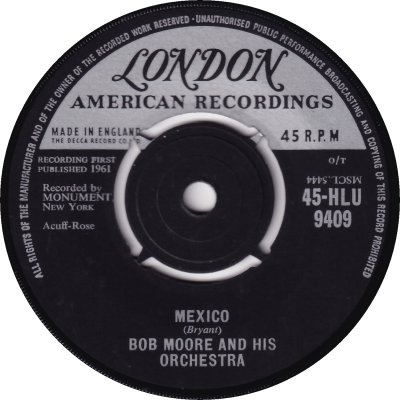
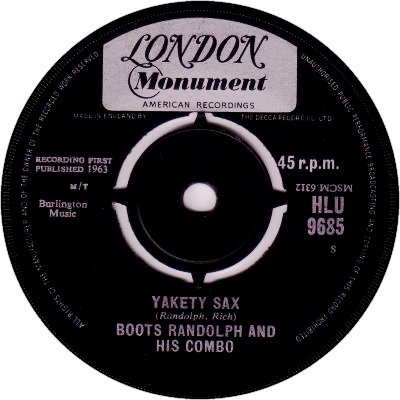
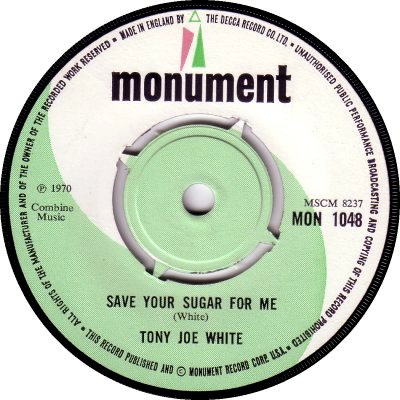
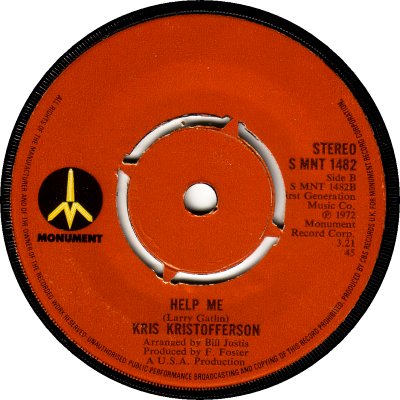
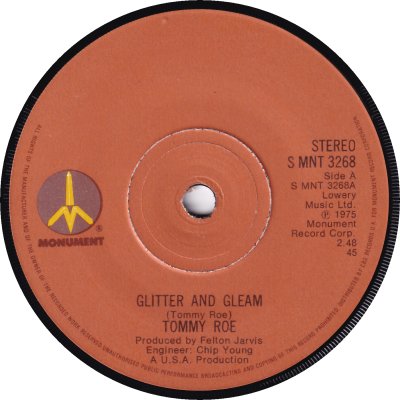
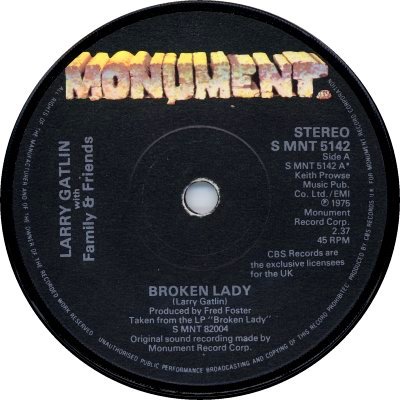

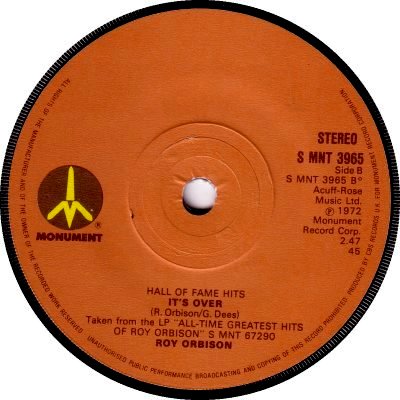
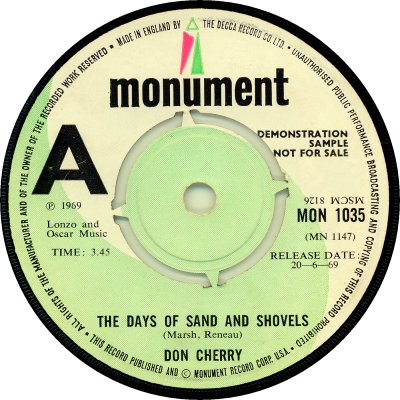
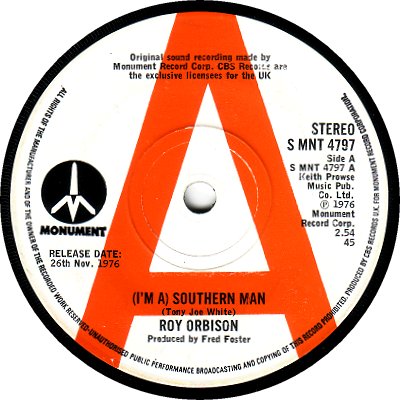

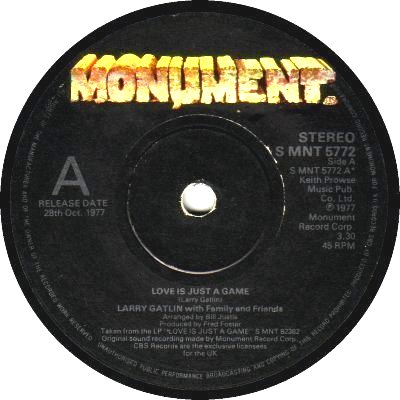

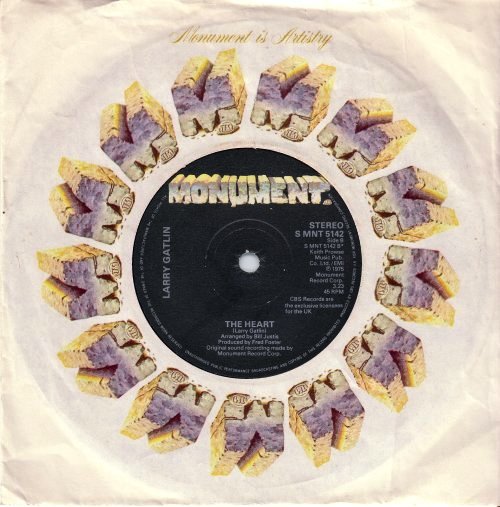
American; out of Baltimore originally, but it soon moved to Nashville. Monument was launched in March 1958 in the USA by Fred Foster, who named it after the Washington monument, a landmark that he had frequently seen during his travels ('Billboard', 21st December 1968). The label got off to a flying start with its first single, 'Gotta Travel On' b/w 'Chasing A Dream' by Billy Grammer, which went on to sell more than a million copies. It quickly widened its interests to cover mainstream Pop and R'n'B, and in September 1959 it released the first single by the man who was to become its biggest international star, Roy Orbison. For the first four-and-a-half years of its existence Monument's records were handled by London, but in the autumn of 1962, after it had enjoyed considerable success, there was an amicable parting of the ways; it undertook an expansion programme, started out as an independent, and began to arrange licensing deals on its own behalf. The loss of Orbison in the summer of 1965 ('BB', 8th June) was a blow, but the company began to develop its interest in Country music. The move paid off, with the likes of Dolly Parton, Jeannie Seeley, Rusty Draper and Grandpa Jones making an impression, and 'BB' of the 25th of May 1968 was able to quote Foster as saying that Monument had had its best quarter-year sales figures so far. In an attempt to capitalize on this success Monument stepped up its international activities by having several of its artists tour abroad ('BB', 16th April 1969). It also looked at licensing material from British companies, signing a three-year deal with Larry Page for records by Judd, Lincoln Black, and the Larry Page Orchestra ('BB', 14th March 1969). The following year 'Billboard' of the 4th of July 1970 added that more deals with UK production companies were being sought.
In the spring of 1971 Monument signed a distribution deal with American Columbia and became one of that company's 'custom' labels. It was to remain with Columbia into the early '80s, while still acting in an independent capacity. It continued to do well on the Country front, thanks to the presence of artists such as Billy Swan, Kris Kristofferson, Charlie McCoy, the band Barefoot Jerry, and latterly Larry Gatlin. 'BB' of the 8th of October 1977 noted that the company had a 'strong Chart presence' with Gatlin 'Heading up the Country singles chart again'. Sadly the impetus seems to have run out at the end of the decade. The number of releases dwindled in 1980 and '81, though an attempt at reactivating the label was made in the latter year ('BB', 8th August). Another attempt was made in September 1982, with Bob Fead being appointed president and a new pressing / distribution deal being signed with CBS ('BB', 4th September). A 'Golden Series' of past hits was issued ('BB', 18th December), but in the middle of 1983 Monument hit the financial buffers and filed for bankruptcy.
In Britain, Monument never managed to make anything like the impression that it did in its home land. Roy Orbison was the only one of its artists to enjoy frequent hit singles here, though it must be said that his run of successes was enviable. While he was with Monument he ran up some sixteen Chart entries, including six that got into the Top 10 and three more which topped the Charts. The No.1s were 'Only The Lonely' b/w 'Here Comes That Song Again' (HLU-9149; 6/60), 'It's Over' b/w 'Indian Wedding' (HLU-9882; 4/64), and 'Oh, Pretty Woman' b/w Yo Te Amo Maria' (HLU-9930; 11/64). All of those hits were on the London label, presumably because of a licensing agreement between Monument and Decca for the UK. The first time that Monument appeared in the Charts under its own name was in 1970, when Tony Joe White took 'Groupy Girl' b/w 'High Sheriff Of Calhoun Parish' (MON-1043; 3/70) to the No.22 position. The only other Monument artists to have hit singles were Robert Knight and Billy Swan, both of whom scored twice. Knight got to No.10 with 'Love On A Mountain Top' b/w 'Power Of Love' (MNT-1875; 10/75), while Swan improved on that, gaining the No.6 spot with 'I Can Help' b/w 'Ways Of A Woman In Love' (MNT-2752; 11/74), but their follow-ups failed to reach those heights. The last regular Monument single came out here in late 1978, though the following year there was a solitary Roy Orbison single in CBS's 'Golden Decade 1967-96' series. Finally late 1982 saw the release of a solitary single by Dolly Parton & Willie Nelson. A 1983 EP of Roy Orbison rarities was only available in promo form - perhaps it got torpedoed by Monument's bankruptcy.
Initially Monument products were released on the London label here, with the licensing company getting a 'Recorded by' mention on the labels (1), but by October 1962 Monument had proved important enough to be given one of London's 'Headstone' labels, with its name being featured quite prominently under that of London itself (2). 'Record Retailer' of the 5th of January 1967 broke the news that under the new licensing agreement Decca was to give Monument its own label. The label duly made its debut that same month, singles being numbered in the MON-1000s (3). When the deal with Decca expired, in December 1970, there was a lull; 'RR' of the 24th of April 1971 noted that no new agreement had yet been signed. It wasn't till August that Monument found a new partner; 'RR' of the 21st of that month revealed that a licensing deal had been struck with CBS. The change was accompanied by a change of label design, to a brown-coloured one featuring a stylized monument (4, 5). Catalogue numbers also changed, the MON-1000s being replaced by an MNT prefix and a numerical block which was shared with the other CBS labels. The company's sole entry in CBS's 'Hall Of Fame Hits' series had text added accordingly (8). Another comprehensive change of design followed in March 1977, with the logo going rocky (6). The numbering remained unchanged, but the placing of the artist's name varied from time to time (7).
Demo labels from the Decca era were issue labels overprinted (9), while demoes of the CBS brown labels were white (10). Demoes of the 'rocky' labels came with several types of overprint (11, 12), that with the small 'A' being the commonest. During 1975 several singles were pressed in mono / stereo form as DJ promos, as was the case with the other CBS family labels at that time. There wasn't a company sleeve in the Decca years; both of the CBS labels were given an appropriate one (13, 14), but plain white sleeves seem to have been used frequently in the mid '70s. The discography below only covers the '70s and '80s.



Copyright 2006 Robert Lyons.

